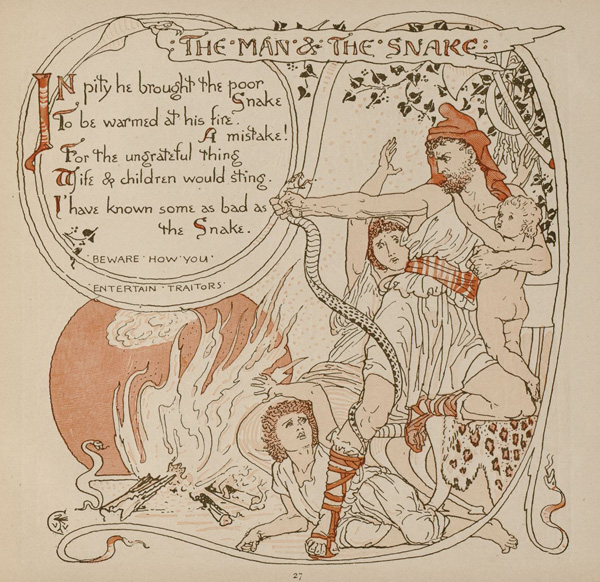READ OUT LOUD. Choose which marked text you prefer to practice with - macrons in verse form, or macrons in prose order, or accent marks in prose order, or focusing on the meter. You will find materials for all of these options below. :-)
VERSE MACRONS. Here is the verse text with macrons (note that reficit has a long final syllable before caesura):
Dum nive candet humus, glacies dum sōpit aquārum
 Cursūs, in colubrum turbida saevit hiems.
Cursūs, in colubrum turbida saevit hiems.Hunc videt, hunc reficit hominis clēmentia; ventum
 Temperat huic tectō, temperat igne gelū.
Temperat huic tectō, temperat igne gelū.Ōre serit vīrus coluber, sīc toxicat aedem.
 Hospes ait colubrō: Nōn reditūrus abī.
Hospes ait colubrō: Nōn reditūrus abī.Nōn exit coluber nec vult exīre, sed haeret
 Amplectēnsque virum sībila dīra movet.
Amplectēnsque virum sībila dīra movet.Reddere gaudet homō nēquam prō melle venēnum,
 Prō fructū poenam, prō pietāte dolum.
Prō fructū poenam, prō pietāte dolum. PROSE MACRONS. Here is the same text with macrons written out in prose word order:
Dum humus nive candet, dum glacies aquārum cursūs sōpit, hiems turbida in colubrum saevit. Hunc videt, clēmentia hominis hunc reficit; huic ventum temperat tectō, gelū temperat igne. Coluber ōre vīrus serit; sīc aedem toxicat. Hospes colubrō ait: Abī, nōn reditūrus. Coluber nōn exit nec vult exīre, sed haeret et, virum amplectēns, sībila dīra movet. Homō nēquam prō melle venēnum, prō fructū poenam, prō pietāte dolum reddere gaudet.
STRESS (ACCENT) MARKS. Here is the prose text with accents, plus some color-coding for the words of three or more syllables (blue: penultimate stress; red: antepenultimate stress):
Dum humus nive candet, dum glácies aquárum cursus sopit, hiems túrbida in cólubrum saevit. Hunc videt, cleméntia hóminis hunc réficit; huic ventum témperat tecto, gelu témperat igne. Cóluber ore virus serit; sic aedem tóxicat. Hospes cólubro ait: Abi, non reditúrus. Cóluber non exit nec vult exíre, sed haeret et, virum ampléctens, síbila dira movet. Homo nequam pro melle venénum, pro fructu poenam, pro pietáte dolum réddere gaudet.
ELEGIAC COUPLET METER. Below I have used an interpunct dot · to indicate the metrical elements in each line, and a double line || to indicate the hemistichs of the pentameter line.
Dum nive· candet hu·mus, glaci·es dum· sōpit a·quārum
 Cursūs,· in colu·brum || turbida saevit hiems.
Cursūs,· in colu·brum || turbida saevit hiems.Hunc videt,· hunc refi·cit homi·nis clē·mentia;· ventum
 Temperat· huic tec·tō, || temperat igne gelū.
Temperat· huic tec·tō, || temperat igne gelū.Ōre se·rit vī·rus colu·ber, sīc· toxicat· aedem.
 Hospes a·it colu·brō: || Nōn reditūrus abī.
Hospes a·it colu·brō: || Nōn reditūrus abī.Nōn ex·it colu·ber nec· vult ex·īre, sed· haeret
 Amplec·tēnsque vi·rum || sībila· dīra mo·vet.
Amplec·tēnsque vi·rum || sībila· dīra mo·vet.Reddere· gaudet ho·mō nē·quam prō· melle ve·nēnum,
 Prō fruc·tū poe·nam, || prō pie·tāte do·lum.
Prō fruc·tū poe·nam, || prō pie·tāte do·lum.IMAGE. Walter Crane's image for this story is fantastic, kind of like Laocoon, but with the man having the serpent in hand this time! In Crane's version of the story, the man manages to get the snake under control before it does any actual damage.

What follows is an unmarked version of the prose rendering to faciliate word searches:
Dum humus nive candet, dum glacies aquarum cursus sopit, hiems turbida in colubrum saevit. Hunc videt, clementia hominis hunc reficit; huic ventum temperat tecto, gelu temperat igne. Coluber ore virus serit; sic aedem toxicat. Hospes colubro ait: Abi, non rediturus. Coluber non exit nec vult exire, sed haeret et, virum amplectens, sibila dira movet. Homo nequam pro melle venenum, pro fructu poenam, pro pietate dolum reddere gaudet.





